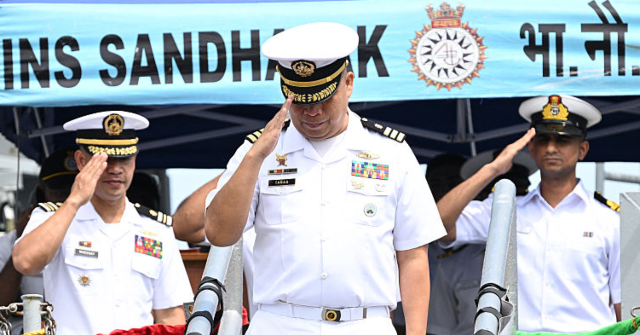Five ships from the Indian and Philippine navies conducted a two-day “joint sail” on Sunday and Monday, marking the first time naval forces from the two countries have patrolled together in the South China Sea.
India committed three ships to the exercise, including a guided missile destroyer, a corvette, and a tanker. The Philippines sent two frigates. The entire two-day sail was conducted within the Philippines’ Exclusive Economic Zone (EEZ) — in other words, sovereign territorial waters lying within 200 nautical miles of the Philippine coast.
The Philippine government has stepped up joint patrols and other cooperative activities with friendly navies over the past two years to counter growing territorial aggression from China.
Philippine Armed Forces Chief of Staff Romeo Brawner said the idea to sail with the Indian navy arose when he met with Indian Armed Forces Chief of Staff Anil Chauhan in March on the sidelines of the Raisina Dialogue, a regional political and economic conference held in New Delhi every year since 2016.
Brawner said one of his goals at this year’s Raisina Dialogue was to bring India and South Korea into “The Squad,” an informal association of nations seeking to counter Chinese aggression in the South China Sea. The existing Squad members are the Philippines, Australia, Japan, and the United States. A good deal of the Squad’s activities involves joint patrols within the Philippines’ EEZ, just like the joint India-Philippine patrol this week.
“We find commonality with India because we have a common enemy. And I’m not afraid to say that China is our common enemy. So, it’s important that we collaborate together, maybe exchange intelligence,” Brawner said in March.
India did not publicly respond to Brawner’s invitation, seemingly preferring to remain quietly amenable to the offer without making statements that would alienate China or its ally Russia. New Delhi was clearly interested in expanding its influence across the South China Sea and the Squad nations, but was reluctant to provoke China or give too much away to the United States during tough trade negotiations with the Trump administration.
Joining the Squad would signal India was developing the kind of close alliance with the U.S. enjoyed by other members, and that would complicate India’s efforts to maintain its close relationship with Russia.
Yet, after months of polite silence on Brawner’s chummy offer to join the Squad, last Sunday Indian warships were seen cruising alongside Philippine frigates the same way Squad members do — including the leading guided missile cruiser of the Indian navy, INS Delhi.
The joint sail coincided with Philippine President Ferdinand Marcos Jr. departing for a five-day visit to India where he intends to lay the groundwork for closer cooperation on trade and maritime security.
On Tuesday, Indian Prime Minister Narendra Modi said stronger defense ties with the Philippines were a symbol of deepening trust between the two countries.
Modi thanked Marcos for the Philippines’ swift condemnation of the Pahalgam terrorist attack in April, an incident that brought India to the brink of war with neighboring Pakistan. Modi’s mention of the incident was significant because India has been disappointed by the reluctance of many allied nations to robustly condemn the attack — or, more to the point, to accept India’s contention that the Pakistani government was an accessory to the brutal terrorist murders.
“India and the Philippines are friends by choice and partners by destiny. Committed to peace, security and rules-based order in the Indo-Pacific; support freedom of navigation as per international laws,” Modi declared, announcing a new “strategic partnership” with the Philippines.
“I think it’s a reaffirmation of the alliance and the partnership that we are strengthening. We used to refer to the Asia Pacific region, we now refer to it as the Indo-Pacific region, which is, I think, a correct evolution of the understanding because of the global nature of all the politics, all the trade, and all of the economy,” Marcos responded.
Brawner said on Friday that the Philippines will be “ordering more equipment and weapon systems” from India. He did not specify what the equipment would be, but Manila has previously purchased shore-based BrahMos supersonic cruise missiles from India.
Upgrading to the sea-launched version of the BrahMos missile would be a logical next step in the strategic partnership announced by Modi and Marcos — and it would be a step guaranteed to infuriate China, since the Philippines’ land-based missiles cannot reach the territory China is attempting to seize.
“Disputes over territory and maritime rights and interests should be settled through negotiation and consultation by countries directly concerned, and no third party is in any position to interfere in that,” Chinese Foreign Ministry spokesman Guo Jiakun sniffed when asked about the joint Indian-Philippines naval exercise on Tuesday.
The People’s Liberation Army Navy (PLAN) of China said it was on “high alert” for Indian involvement in South China Sea disputes following the joint sail between India and the Philippines.
Read the full article here


